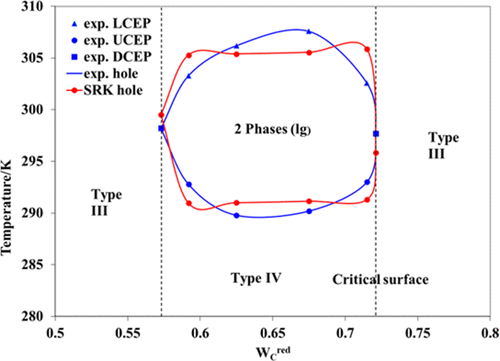当前位置:
X-MOL 学术
›
J. Chem. Eng. Data
›
论文详情
Our official English website, www.x-mol.net, welcomes your
feedback! (Note: you will need to create a separate account there.)
Phase Equilibria in Ternary Systems Carbon Dioxide + 1-Hexanol + n-Pentadecane and Carbon Dioxide + 1-Heptanol + n-Pentadecane: Modeling of Holes in Critical Surface and Miscibility Windows
Journal of Chemical & Engineering Data ( IF 2.0 ) Pub Date : 2017-12-18 00:00:00 , DOI: 10.1021/acs.jced.7b00781 Dan Geană 1
Journal of Chemical & Engineering Data ( IF 2.0 ) Pub Date : 2017-12-18 00:00:00 , DOI: 10.1021/acs.jced.7b00781 Dan Geană 1
Affiliation

|
In this paper, the modeling of holes in the critical surface and miscibility windows, in the ternary carbon dioxide + 1-hexanol + n-pentadecane and carbon dioxide + 1-heptanol + n-pentadecane systems, was made. A software for phase equilibrium (PHEQ) data management and applications was used for calculations with the cubic general equation of state (GEOS), developed by the author. The software PHEQ was extended for calculations of critical lines (module GEOS CRITHK), using the Heidemann and Khalil method, and liquid–liquid–vapor (llg) lines (module GEOS LLVE) in binary and ternary mixtures. These modules were used for the calculation of holes in critical surfaces, and of miscibility windows. Binary and quasi-binary measured phase equilibrium data by Scheidgen [Ph.D. Thesis, Ruhr-Universität Bochum, 1997] were necessary for understanding and modeling of ternary systems, regarding holes in critical surface and miscibility windows. For modeling, the equation of state Soave–Redlich–Kwong, integrated in the cubic GEOS form, coupled with the two-parameters conventional mixing rule was used. A simple semipredictive approach was adopted for the estimation of the two binary interaction parameters by a trial and error procedure for reproducing the temperature and pressure values of the two experimental double critical end points (DCEPs). A unique set of parameters obtained by this procedure was used to predict the critical and three phases llg lines for all quasi-binary systems at reduced mass fractions of n-pentadecane in the range between the two experimental DCEPs. The calculated holes in the critical surface and miscibility windows are in satisfactory agreement with the available experimental data.
中文翻译:

三元体系中的相平衡二氧化碳+ 1-己醇+正十五烷和二氧化碳+ 1-庚醇+正十五烷:关键表面中的孔和混溶性窗口的建模
在本文中,对三元二氧化碳+ 1-己醇+ n-十五烷和二氧化碳+ 1-庚醇+ n中临界表面和混溶性窗口中的孔进行建模-pentadecane系统,已制成。作者开发了一种用于相平衡(PHEQ)数据管理和应用的软件,用于计算立方状态总方程(GEOS)。使用Heidemann和Khalil方法扩展了PHEQ软件,用于计算临界线(模块GEOS CRITHK),以及二元和三元混合物中的液-液-汽(llg)线(模块GEOS LLVE)。这些模块用于计算关键表面上的孔和可混溶性窗口。Scheidgen [Ph.D. 论文,Ruhr-UniversitätBochum,1997]对于理解和建模三元系统,对于关键表面的孔和可混溶性窗口是必要的。为了进行建模,将状态方程Soave–Redlich–Kwong集成为三次GEOS形式,结合两个参数,使用常规混合规则。采用简单的半预测方法,通过反复试验的方法估算两个二元相互作用参数,以再现两个实验双临界终点(DCEP)的温度和压力值。通过该程序获得的一组独特的参数用于预测所有准二元系统在质量分数降低时的临界和三相llg谱线。两个实验DCEP之间的正十五烷。临界表面和溶混度窗口中的计算孔与可用的实验数据令人满意地吻合。
更新日期:2017-12-18
中文翻译:

三元体系中的相平衡二氧化碳+ 1-己醇+正十五烷和二氧化碳+ 1-庚醇+正十五烷:关键表面中的孔和混溶性窗口的建模
在本文中,对三元二氧化碳+ 1-己醇+ n-十五烷和二氧化碳+ 1-庚醇+ n中临界表面和混溶性窗口中的孔进行建模-pentadecane系统,已制成。作者开发了一种用于相平衡(PHEQ)数据管理和应用的软件,用于计算立方状态总方程(GEOS)。使用Heidemann和Khalil方法扩展了PHEQ软件,用于计算临界线(模块GEOS CRITHK),以及二元和三元混合物中的液-液-汽(llg)线(模块GEOS LLVE)。这些模块用于计算关键表面上的孔和可混溶性窗口。Scheidgen [Ph.D. 论文,Ruhr-UniversitätBochum,1997]对于理解和建模三元系统,对于关键表面的孔和可混溶性窗口是必要的。为了进行建模,将状态方程Soave–Redlich–Kwong集成为三次GEOS形式,结合两个参数,使用常规混合规则。采用简单的半预测方法,通过反复试验的方法估算两个二元相互作用参数,以再现两个实验双临界终点(DCEP)的温度和压力值。通过该程序获得的一组独特的参数用于预测所有准二元系统在质量分数降低时的临界和三相llg谱线。两个实验DCEP之间的正十五烷。临界表面和溶混度窗口中的计算孔与可用的实验数据令人满意地吻合。











































 京公网安备 11010802027423号
京公网安备 11010802027423号